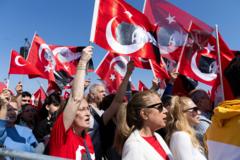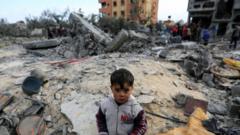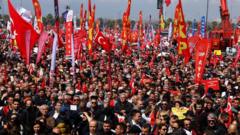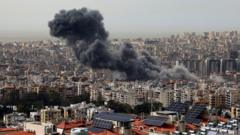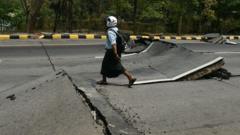In a rare display of dissent, Gazans are challenging Hamas's rule while enduring intensifying conflict with Israel.
Gaza Residents Challenge Hamas Amid Ongoing Conflict

Gaza Residents Challenge Hamas Amid Ongoing Conflict
Protests in Beit Lahia mark a significant shift against Hamas's authority.
---
Amid the ongoing conflict between Israel and Hamas, residents of Beit Lahia have turned to the streets in protest, marking a decisive shift in the power dynamics within Gaza. Initiated after Israeli airstrikes caused devastation in their community, these protests are demanding both an end to the conflict and an end to Hamas's nearly two-decade-long reign over the territory. As helicopters surveyed the wreckage and an evacuation order loomed, residents banded together to voice their frustrations, with calls echoing throughout the region.
Demonstrators have stressed the urgent need for change, reflecting a burgeoning desire for a peaceful existence separate from the violence they have faced for years. “Hamas needs to go away,” declared Ahmad al-Masri, a protest organizer, underlining the lack of fear that has traditionally silenced dissent in the face of potential repercussions from Hamas.
Historically, Hamas has enforced strict control over public dissent, often meting out harsh reprisals against those who challenge its governance. However, recent protests are characterized by a significant absence of the group's security forces, suggesting a potential shift in their grip on power due to intense scrutiny and vulnerability amid Israeli airstrikes.
The gathered crowds rallied in Beit Lahia, inspired by a social media message that circulated among locals, imploring them to join the movement: “The square is calling on you. Enough of wars. We want to live in peace.” This surge of popular will for change comes as the region grapples with the devastation of failed ceasefire negotiations, leaving many to confront the dire living conditions directly linked to Hamas's governance.
Despite the small size of the protests, their implications carry heavy weight. This could signify a new chapter for Gazans who have long felt powerless, as they question a leadership that many believe has failed them. Political analysts highlight the precarious position of Hamas, suggesting that it may find itself increasingly challenged by a population that has reached its breaking point.
As protests spread beyond Beit Lahia, the urgency for change resonates louder, with residents urging their neighbors to join them in seeking a life unbound by persistent conflict and destruction.
Amid the ongoing conflict between Israel and Hamas, residents of Beit Lahia have turned to the streets in protest, marking a decisive shift in the power dynamics within Gaza. Initiated after Israeli airstrikes caused devastation in their community, these protests are demanding both an end to the conflict and an end to Hamas's nearly two-decade-long reign over the territory. As helicopters surveyed the wreckage and an evacuation order loomed, residents banded together to voice their frustrations, with calls echoing throughout the region.
Demonstrators have stressed the urgent need for change, reflecting a burgeoning desire for a peaceful existence separate from the violence they have faced for years. “Hamas needs to go away,” declared Ahmad al-Masri, a protest organizer, underlining the lack of fear that has traditionally silenced dissent in the face of potential repercussions from Hamas.
Historically, Hamas has enforced strict control over public dissent, often meting out harsh reprisals against those who challenge its governance. However, recent protests are characterized by a significant absence of the group's security forces, suggesting a potential shift in their grip on power due to intense scrutiny and vulnerability amid Israeli airstrikes.
The gathered crowds rallied in Beit Lahia, inspired by a social media message that circulated among locals, imploring them to join the movement: “The square is calling on you. Enough of wars. We want to live in peace.” This surge of popular will for change comes as the region grapples with the devastation of failed ceasefire negotiations, leaving many to confront the dire living conditions directly linked to Hamas's governance.
Despite the small size of the protests, their implications carry heavy weight. This could signify a new chapter for Gazans who have long felt powerless, as they question a leadership that many believe has failed them. Political analysts highlight the precarious position of Hamas, suggesting that it may find itself increasingly challenged by a population that has reached its breaking point.
As protests spread beyond Beit Lahia, the urgency for change resonates louder, with residents urging their neighbors to join them in seeking a life unbound by persistent conflict and destruction.






